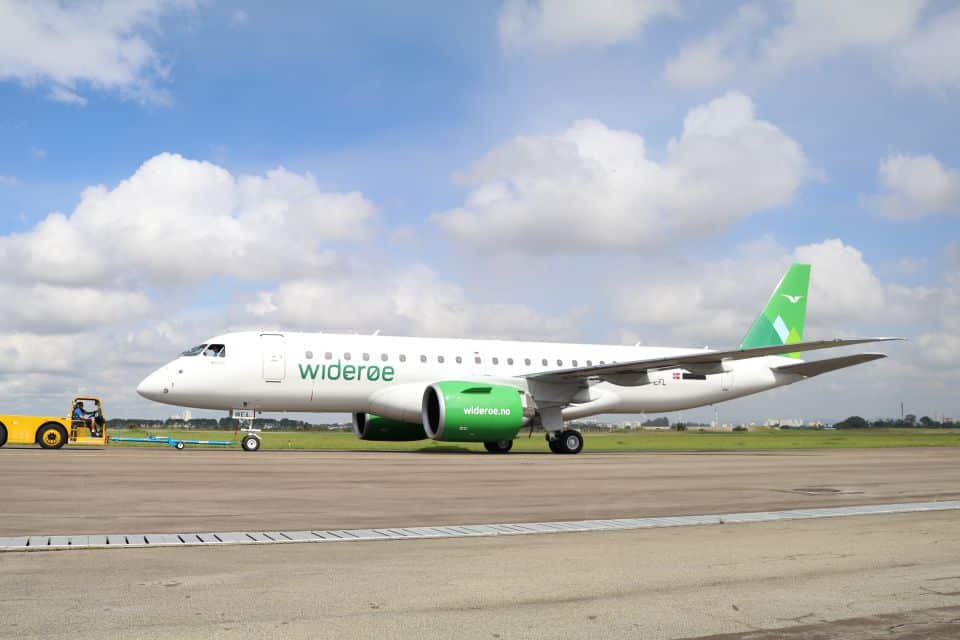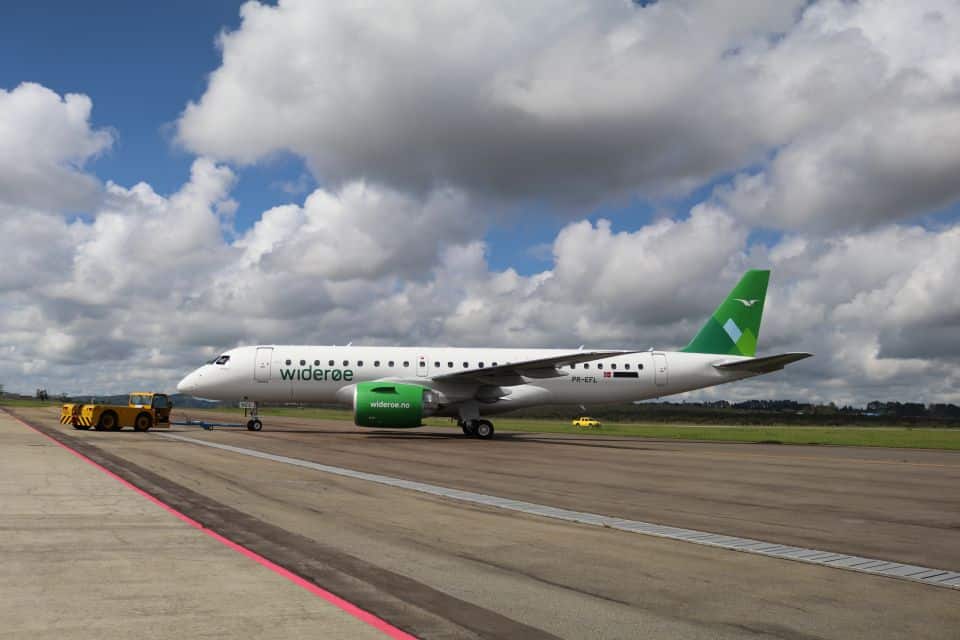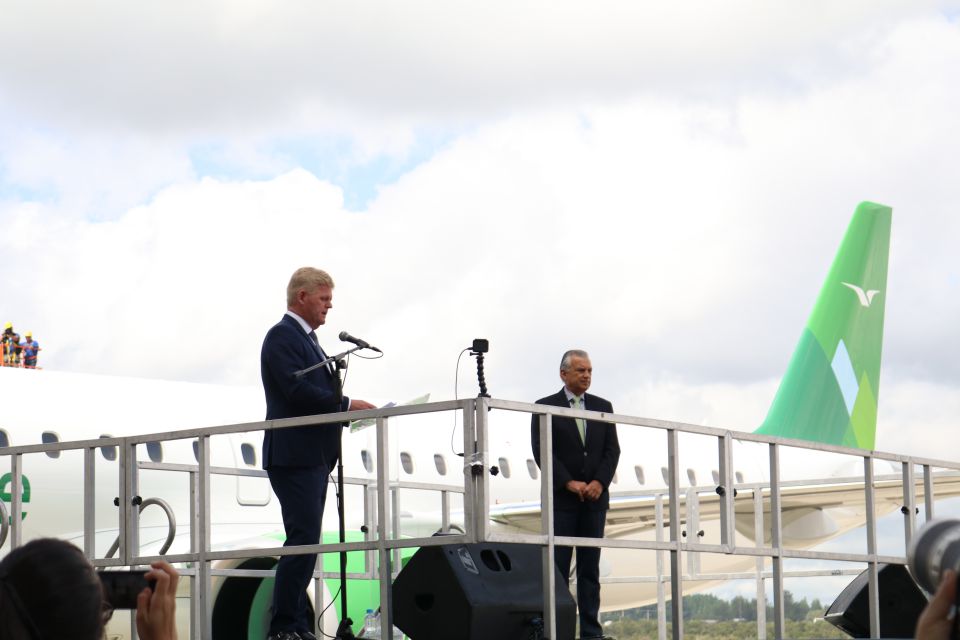Aviation
Norway’s Widerøe Receives World’s First Embraer E190-E2 Jet
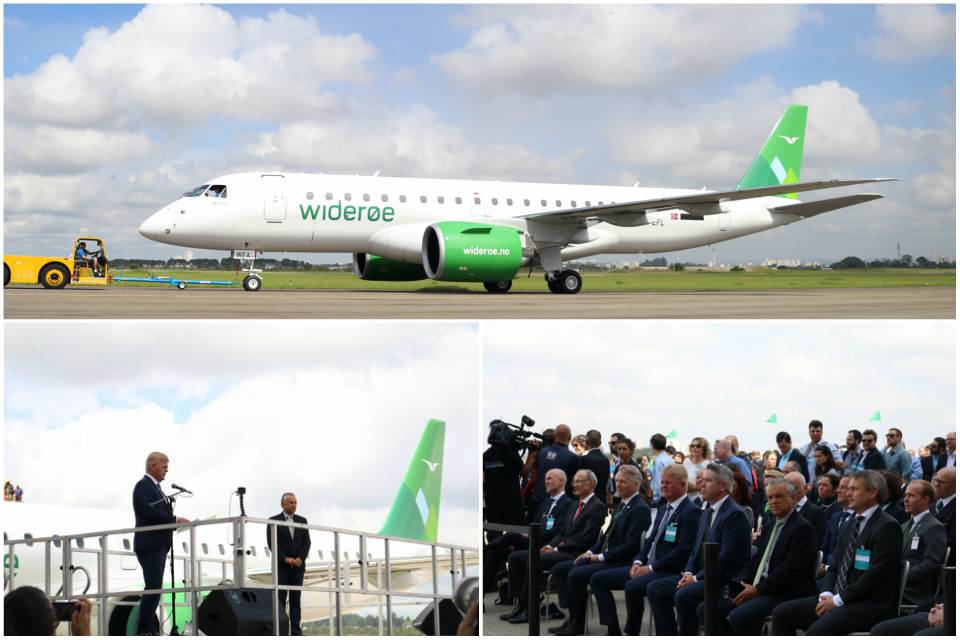
Norway’s Widerøe Receives World’s First Embraer E190-E2 Jet
São José dos Campos, Brazil, April 4, 2018 – Embraer and Widerøe, Scandinavia’s largest regional airline, celebrated the delivery of the manufacturer’s first production E190-E2 today at a ceremony at Embraer’s facility in São José dos Campos. The Norwegian airline will start flying the new aircraft on domestic routes later this month.
The E190-E2 is the first of three new-generation aircraft seating from 80 to 146-seat E-Jets to be introduced through 2021. Widerøe’s E190-E2 is configured with 114 seats in a single-class layout. Widerøe has contracted for up to 15 E-Jets E2s – three firm E190-E2 orders and purchase rights for an additional 12 E2s. The total value of the order is approximately USD 873 million if all rights are exercised.
“The E190-E2 is an impressive aircraft. It is the ideal airplane for Widerøe as we introduce jets for the first time in the company’s 84-year history,” said Stein Nilsen, Chief Executive Officer of Widerøe. “I am convinced our passengers are going to love the cabin, our operations people are going to embrace the new technology, while our financial collaborators will appreciate the economics the aircraft permits. I believe everyone is going to celebrate with, as the launch customer, the fact that we are the first airline to fly the world’s most environmentally-friendly airplane. With the lowest noise and emissions among aircraft in its category.”
“This is a historic day for the E-Jets program and for Embraer. The delivery of this E2 marks a continuation of a real success story in global aviation. I’m honored that Widerøe – such a respected and experienced airline – is our lunch operator” said John Slattery, President & CEO, Embraer Commercial Aviation. “I’m also delighted to welcome Widerøe as our newest Embraer customer and want to thank Stein and his team for the support over the last year; working together with us as partners to deliver this airplane today. I’m planning on being on the aircraft when it first enters Norwegian airspace next week and really looking forward to that!”
The E190-E2 received Type Certification on February 28. It is the first time an aircraft program with the level of complexity of the E2 has received Type Certificates simultaneously from three major worldwide authorities: Brazil’s Civil Aviation Agency (Agência Nacional de Aviação Civil – ANAC), the FAA (the U.S. Federal Aviation Administration) and EASA (European Aviation Safety Agency).
The E190-E2 features new ultra-high bypass ratio engines and a completely new wing and landing gear. Compared to the first-generation E190, 75% of the aircraft systems are new. Embraer recently announced some final flight tests results confirming the E2 as the most efficient single-aisle aircraft on the market. In fuel consumption, the E190-E2 proved to be 1.3% better than originally expected, a 17.3% improvement compared to the current- generation E190.
The E190-E2 is also the aircraft with the lowest level of external noise and emissions in the segment. Flight test results also confirmed the E190-E2 to be better than its original specification in takeoff performance. The aircraft’s range from airports with hot-and-high conditions, such as Denver and Mexico City, increases by 600 nm compared to current generation aircraft. Its range from airports with short runways, such as London City, also increases by more than 1,000 nm allowing the aircraft to reach destinations like Moscow and the north of Africa.
The E190-E2 will also have the longest maintenance intervals among single-aisle aircraft with 10,000 flight hours for basic checks and no calendar limit for typical utilization. This means an additional 15 days of aircraft utilization over ten years compared to current generation E-Jets. Another key gain is with pilot transition training time. Pilots of current-generation E-Jets will need only 2.5 days of training and no full flight simulator to be qualified to fly an E2.
Widerøe’s E190-E2 fleet will have the support of the Flight Hour Pool Program which covers more than 300 key rotable components. Embraer’s Flight Hour Pool Program, which currently supports more than 40 airlines worldwide, is designed to allow airlines to minimize their upfront investment in expensive repairable inventories and resources and take advantage of Embraer’s technical expertise and vast component repair service provider network. This results in significant savings in repair and inventory carrying costs, reduction in required warehouse space, and the elimination of resources required for repair management, all while providing guaranteed performance levels.
Embraer is the world’s leading manufacturer of commercial jets with up to 150 seats. The Company has 100 customers from all over the world operating the ERJ and the E-Jet families of aircraft. For the E-Jets program alone, Embraer has logged more than 1,800 orders and 1,400 deliveries, redefining the traditional concept of regional aircraft by operating across a range of business applications.

Aviation
Lost Tool Found in Qantas A380 After 34 Flights
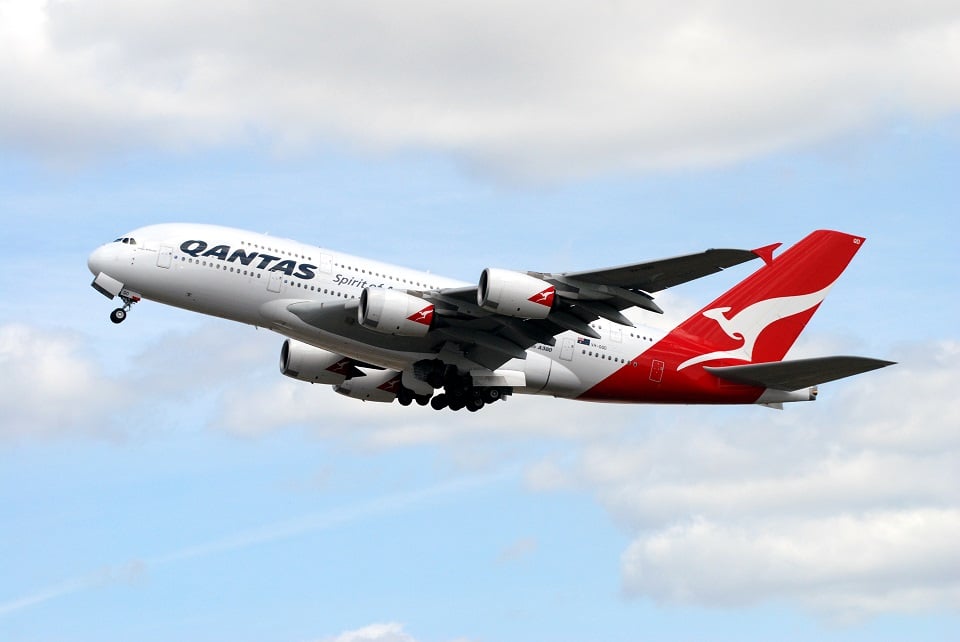
An Australian Transportation Safety Bureau (ATSB) investigation recently revealed that a Qantas A380 operated 34 flights with a 1.25-meter nylon tool lodged in one of its engines.
This turning tool, used during borescope inspections to rotate the intermediate-pressure compressor, was left behind during scheduled maintenance at Los Angeles on December 6, 2023. It remained inside the engine until it was discovered by maintenance staff during a subsequent check at Los Angeles on January 1, 2024.
China Takes the Lead in Sixth-Generation Fighters with White Emperor B
The ATSB report highlights two critical lapses. First, maintenance engineers failed to notice the tool during final checks for foreign objects after the borescope inspection. Second, the lost tool procedure was not activated when the tool was identified as missing.
The certifying engineer ultimately cleared the aircraft for service without accounting for the misplaced tool. During the time qantas films the tool was inside, the A380 completed 34 flight cycles, accumulating nearly 294 hours without any noticeable effect on engine performance.
Although the tool was deformed by high-energy airflow within the engine, there was no reported damage to the engine itself. ATSB Chief Commissioner Angus Mitchell commented.
India’s C-295 to Gain Advanced Weapons for Maritime Surveillance
“This incident underscores the importance of following established maintenance protocols. Engineers missed the tool during foreign object checks, and the required lost tool procedure wasn’t started after realizing the tool was missing.”
Following the investigation, the airline issued a safety directive, urging all engineering and tool storage teams to adhere strictly to these protocols to prevent similar incidents in the future.
A qantas spokesperson stated, “While the tool didn’t impact engine performance, we take this incident very seriously. It is critical to follow the correct lost tool procedures.”
-

 Aviation2 months ago
Aviation2 months agoBoeing confirms 797: A New Era for Mid-Size Aircraft
-

 Aviation2 months ago
Aviation2 months agoMicrosoft Flight Simulator Raises $3 Million to Bring Back the An-225 Mriya
-

 Aviation2 months ago
Aviation2 months agoLockheed and Tata Team Up to Build C-130J MRO Facility in India
-

 Airlines2 months ago
Airlines2 months agoQantas Engineers Stage Walkout Over Cost of Living Concerns
-

 Airlines2 months ago
Airlines2 months agoQatar Citizens Can Travel to the United States Without a Visa
-

 Aviation2 months ago
Aviation2 months agoBoeing Offers 25% Pay Increase & Promise to Build Next Plane in Seattle
-

 Aviation2 months ago
Aviation2 months agoQatar Airways bans these new Electronic Devices on plane
-

 Airlines2 months ago
Airlines2 months agoEmirates Ends 28-Year Singapore-Melbourne Fifth Freedom Route


